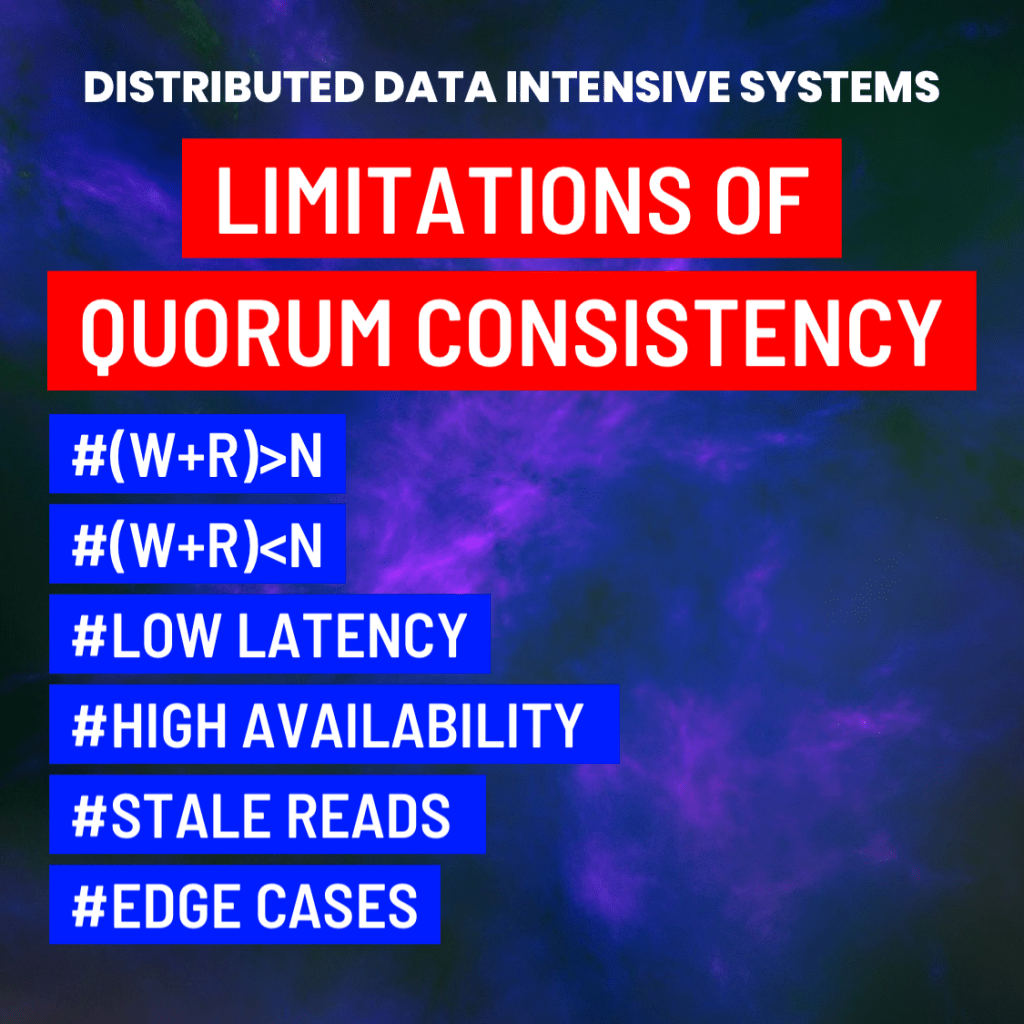Quorum Variables (before diving into this subject)
- W = Minimum write nodes
- R = Minimum read nodes
- N = Nodes in quorum group
(W + R) > N
If you have N replicas and you choose W and R such as (W+R) > N you will generally expect every read to return the most recent value written.
- This is the case because the set nodes for once you have written and the set of nodes for which you have read must overlap.
- That is among the nodes you read, there must be at least one node with the latest value
- Often R and W are chosen to be the majority of nodes
- More than N over 2
- This shows the quorum condition is met
- Whilst still tolerating N over 2 node failures
- More than N over 2
Pros
- Less likely to incur stale reads (more accurate reads)
- Utilising more nodes (not exclusive to this) will allow you to withstand node outages
Cons
- Can impact high availability as the system requires more successful responses from W and therefore we can expect increase latency as there are more responses to be confirmed
- Edge cases may occur still where we find stale reads

(W + R) < N
But Quorums are not simply majorities, it is only matters if the sets of nodes used by read write operations overlap at least one node.
- Other quorum assignments are possible…
- That allow flexibility on the design of distributed algorithms
You may even want W and R to be smaller numbers!
- (W+R) < N
- In which case the quorum condition is not satisfied
- Here read and writes will still be set to N nodes
- But a smaller number of successful responses is required for the operations to succeed
- With smaller W and R you are more likely to read stale values
- Because it is more likely that your read did not include the node with the latest value
- On the upside this configuration allows lower latency and higher availability
- If there is a network interruption and many replicas become unreachable, there is a higher chance you can continue to process reads and writes
- Only after the number of reachable replicas falls below W or R does the database become unavailable for writing and reading respectively
Pros
- Lower latency
- Higher availability
Cons
- Stale reads are more likely

Edge Cases
These depend on the implementations.
- Possible scenarios
- If a sloppy quorum is used
- The W writes may end up on different nodes than the R reads
- So there is no longer a guarantee the overlap between R nodes and W nodes
- If there are two writes that happen concurrently
- It is not clear which one happens first
- The only safe solution is to merge the concurrent writes
- If a winner is picked on the timestamp (the last write wins)
- Writes can be lost due to clock skew
- If write happens concurrently with a read, a write may be reflected on the only some of the replicas
- In this case it is undetermined whether the read returns the old or new value
- If a write succeeded on some replicas but failed on others
- Example because the discs on some nodes are full and the overall succeed on fewer than W replicas it is not rolled back on the replicas where it succeeded
- This means if a write is reported as failed
- Subsequent reads may or may not return that value from the write
- If a node carrying a new value fails and its data is restored from an old replica carrying a value
- The number of replicas storing new value may fall below W breaking the quorum condition
- Even if everything is working correctly, there are edge cases where you can get unlucky with timing
- Example because the discs on some nodes are full and the overall succeed on fewer than W replicas it is not rolled back on the replicas where it succeeded
Final note
Thus, although quorums may appear to guarantee that reads return the latest written value…
- In practice it is not so simple
- Dynamo styled databases are generally optimised for uses cases to tolerate eventual consistency
- The parameters W and R allow you to adjust the probability of value being read
- But do not take them as an absolute guarantee
- In particular we do not usually get the guarantees problems with replication lag
- So the previous mentioned anomalies
- Reading then writes
- Monatonic reads
- Consistent prefix reads
- Can still occur in applications…
- Stronger guarantees generally require transactions and consensus!
📚 Further Reading & Related Topics
If you’re exploring quorum consistency and its trade-offs in distributed systems, these related articles will provide deeper insights:
• Distributed Data-Intensive Systems: Logical Log Replication – Learn how logical log replication helps maintain consistency across distributed databases, complementing quorum-based approaches.
• Resolving Write Conflicts in Distributed Data-Intensive Systems – Understand how distributed systems handle conflicting writes and ensure data integrity, which is a key challenge when working with quorum consistency models.









Leave a comment